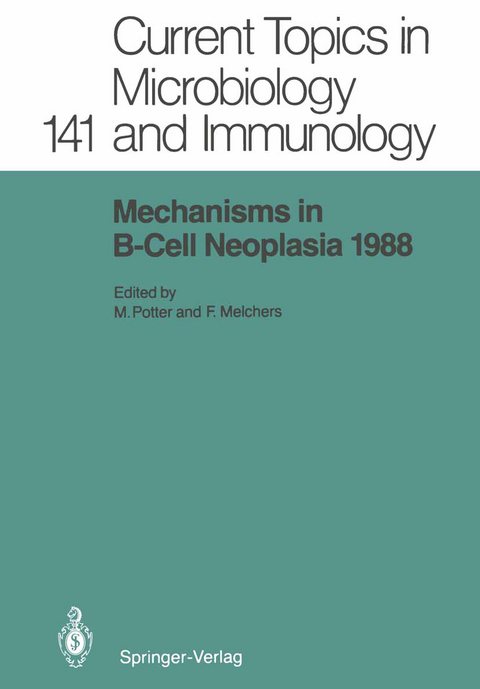
Mechanisms in B-Cell Neoplasia 1988
Springer Berlin (Verlag)
978-3-642-74008-4 (ISBN)
Michael Potter is Reader in the Philosophy of Mathematics at Cambridge University. He is the author of Sets (OUP, 1990), Reason's Nearest Kin (OUP, 2000), Set Theory and its Philosophy (OUP, 2004), and Mathematical Knowledge (edited with Mary Leng and Alexander Paseau, OUP, 2007).
I: Pathogenetic Mechanisms.- Early B Cell Tumors.- B Cell Precursors in Bone Marrow: In Vivo Proliferation, Localization, Stimulation by Activated Macrophages and Implications for Oncogenesis.- Lymphoid-Restricted Stem Cells.- Recombinant Interleukin-7 Supports the Growth of Normal B Lymphocyte Precursors.- Mac-1+ Bone Marrow Cells Include Precursors of B Cells and T Cells.- Molecular Characterization of a Transforming Retrovirus Involved in Pre-B Cell Lymphomas.- In Vitro Transformation of Murine Bone Marrow Cells with a v-raf/v-myc Retrovirus Yields Clonally Related Mature B Cells and Macrophages.- Closely Related BCR/ABL Oncogenes Are Associated with the Distinctive Clinical Biologies of Philadelphia Chromosome Positive Chronic Myelogenous and Acute Lymphocytic Leukemia.- The Pathogenesis of Tumors Induced by Helper Virus-Free Abelson Murine Leukemia Virus.- The Development of Three Distinct Avian B Cell Lymphomas.- Bursal Stem Cells as Targets for myc-Induced Preneoplastic Proliferation and Maturation Arrest.- Molecular Analysis, of an AIDS-Associated Burkitt's Lymphoma: Near-Identity with Endemic Cases.- B Cell and Plasma Cell Tumors.- Transgenic Mouse Models for Hematopoietic Tumorigenesis.- Genetic Studies on Eµ-myc Transgenic Mice.- Differential Expression of myc-family Genes During Development: Normal and Deregulated N-myc Expression in Transgenic Mice.- Plasmacytoma Induction by J Series of v-myc Recombinant Retroviruses: Evidence for the Requirement of Two (raf and myc) Oncogenes for Transformation.- Synergy of an IgH Promoter-Enhancer-Driven c-myc/v-Ha-ras Retrovirus and Pristane in the Induction of Murine Plasmacytomas.- The Genetics of Susceptibility to RIM-Induced Plasmacytomagenesis.- Significance of Chromosome 8 Breakpoint Location in Burkitt'sLymphoma: Correlation with Geographical Origin and Association with Epstein-Barr Virus.- B Cell Proliferation in Follicles, Germinal Centre Formation and the Site of Neoplastic Transformation in Burkitt's Lymphoma.- Altered Growth Phenotype of a Burkitt's Lymphoma Line Following the Introduction and Stable Expression of the EBNA 2A Gene.- Soluble CD23/BLAST-2 (S-CD23/Blast-2) and Its Role in B Cell Proliferation.- Burkitt's Lymphoma Variant Translocations: Distribution of Chromosomal Breakpoints and Perturbated Regulation of a Mutated c-myc Gene.- Differentiation Associated c-myc Expression in Phorbol Ester and Lymphokine Stimulated B-Type Chronic Lymphocytic Leukemia Cells.- B and T Cell Responses Induced by Interleukin-6.- II: Studies of B Cell Relevant Oncogenes.- c-myc.- Prediction of a Dimerization Surface Common to a New Class of Sequence-Specific DNA Binding Proteins.- Immunological Probes in the Analysis of myc Protein Expression.- The Replication Activity of SV40 DNA Correlates with the Level of c-myc Expression in Human Tumor Cell Lines.- Elevated Levels of the c-myc Protein in Bloom's Syndrome and Induction of c-myc by DNA Strand Breakage.- Deregulation of the c-myc and N-myc Genes in Transformed Cells.- Stimulation of the Antigen Receptor Complex Leads to Transcriptional Activation of the c-myc Gene in Normal Human T Cells.- A Repressor of c-myc Transcription Is Found Specifically in Plasmacytomas.- Regulation of c-myc Gene Transcription in B Lymphocytes: Mechanisms of Negative and Positive Control.- Multifactorial Regulation of the Human c-myc Oncogene.- Negative Control Elements Within and Near the Murine c-myc Gene.- Disruption of the Putative c-myc Auto-Regulation Mechanism in a Human B Cell Line.- Deregulated Expression of an Activated Alleleof Human c-myc in Transfected Fibroblast Cultures.- Comparison of c-, N-, and L-myc Transcriptional Regulation.- Delivery of c-myc Antisense Phosphorothioate Oligodeoxynucleotides to Hematopoietic Cells in Culture by Liposome Fusion: Specific Reduction in c-myc Protein Expression Correlates with Inhibition of Cell Growth and DNA Synthesis.- Different Biological Effects of c-myc and H-ras Oncogene Expression in EBV-Infected Human Lymphoblasts.- c-abl.- Abrogation of IL-3 Dependence of Myeloid FDC-P1 Cells by Tyrosine Kinase Oncogenes Is Associated with Induction of c-myc.- U.R. RAPP The Abelson Protein Is Required for Initiation and Maintenance for Transformation in Murine Pre-B Cells.- c-myb.- Expression and Function of the c-myb Oncogene During Hematopoietic Differentiation.- Sense and Anti-sense Transcription in the Murine c-myb Attenuator Region.- bcl-2.- Expression of the Murine Proto-Oncogene bcl-2 Is Stage Specific and Cell-Type Specific.- Recent Progress on the Human bcl-2 Gene Involved in Follicular Lymphoma: Cheracterization of the Protein Products.
| Erscheint lt. Verlag | 8.12.2011 |
|---|---|
| Reihe/Serie | Current Topics in Microbiology and Immunology |
| Zusatzinfo | XIV, 340 p. |
| Verlagsort | Berlin |
| Sprache | englisch |
| Maße | 170 x 244 mm |
| Gewicht | 620 g |
| Themenwelt | Medizin / Pharmazie ► Medizinische Fachgebiete ► Dermatologie |
| Medizin / Pharmazie ► Medizinische Fachgebiete ► Onkologie | |
| Studium ► Querschnittsbereiche ► Infektiologie / Immunologie | |
| Naturwissenschaften ► Biologie ► Biochemie | |
| Schlagworte | Cell • leukemia • Lymphoma • Mutation • Tumor • Virus |
| ISBN-10 | 3-642-74008-1 / 3642740081 |
| ISBN-13 | 978-3-642-74008-4 / 9783642740084 |
| Zustand | Neuware |
| Haben Sie eine Frage zum Produkt? |
aus dem Bereich


